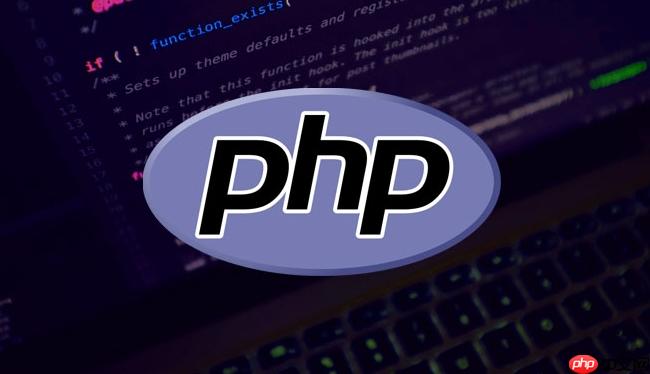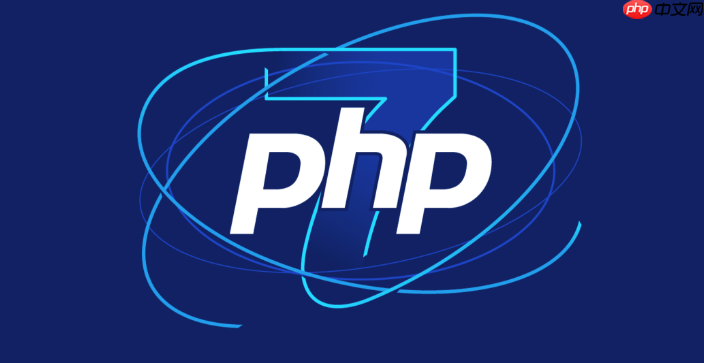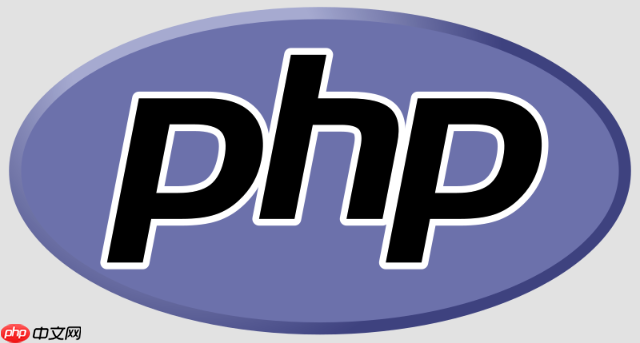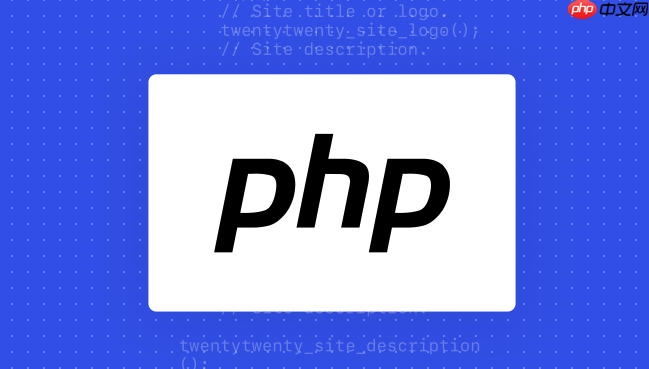 Backend Development
Backend Development
 PHP Tutorial
PHP Tutorial
 How to use PHP to develop a Q&A community platform Detailed explanation of PHP interactive community monetization model
How to use PHP to develop a Q&A community platform Detailed explanation of PHP interactive community monetization model
How to use PHP to develop a Q&A community platform Detailed explanation of PHP interactive community monetization model
Jul 23, 2025 pm 07:21 PM1. The first choice for the Laravel MySQL Vue/React combination in the PHP development question and answer community is the first choice for Laravel MySQL Vue/React combination, due to its maturity in the ecosystem and high development efficiency; 2. High performance requires dependence on cache (Redis), database optimization, CDN and asynchronous queues; 3. Security must be done with input filtering, CSRF protection, HTTPS, password encryption and permission control; 4. Money optional advertising, member subscription, rewards, commissions, knowledge payment and other models, the core is to match community tone and user needs.

Speaking of the development Q&A community, PHP language, I personally think it is still a very reliable choice. It has a mature ecosystem, a huge community, and is flexible. It is like a fish in water for quickly building and iterating an interactive platform. As for monetization, it is nothing more than advertising, advanced feature subscriptions or content cooperation, but how to play depends on your community tone.

Solution
To use PHP to develop a Q&A community platform, we have to start with several core points. First, you need to have a solid backend skeleton. I usually tend to choose a mature PHP framework, such as Laravel or Symfony. They provide a series of out-of-the-box functions such as MVC architecture, ORM, routing, and certification, which can save you a lot of time in remaking wheels and focus more on business logic.
In terms of databases, MySQL or PostgreSQL is standard, and it is crucial to design the structure of core tables such as users, questions, answers, comments, labels, and voting. For example, in addition to the title and content, the question table also has to have user ID, release time, and whether the answer was adopted; the answer table must be associated with the question ID and the answerer ID.

As for the front-end, although PHP itself is good at server-side rendering, in order to make the user experience smoother, I personally consider combining some modern JavaScript frameworks, such as Vue.js or React, and using them to handle the front-end interactive logic, such as real-time updates of likes and comments, or dynamic loading of search results. Of course, if the initial budget or time of the project is limited, pure PHP template engines (such as Blade or Twig) can do a good job, but they may not be that "silky" in interaction.
In terms of specific functions, the core of the Q&A community is nothing more than:

- User system: Register, log in, and retrieve passwords, these are the cornerstones.
- Question release and management: Users can ask questions, edit and delete their own questions.
- Answers and comments: Users can answer questions and comment on questions or answers.
- Voting mechanism: Agree or object to questions and answers, which is the key to community interaction and content screening.
- Tag system: facilitates problem classification and retrieval, and also helps users discover content of interest.
- Search function: It must be available, and it must be easy to use, otherwise users will be crazy if they cannot find the content.
- Notification system: Someone responded to my question, someone commented on my answer, and these information must be pushed in time.
During the development process, you will soon encounter some challenges, such as how to deal with data consistency under high concurrency, or how to prevent various cyber attacks. These are not small problems, so you have to plan ahead.
What are the mainstream technology stack choices for PHP development Q&A community platform?
To be honest, there are quite a few technology stacks in the PHP ecosystem that can be used to build a Q&A community, but if you want to say "mainstream" and "reliable", I have several combination punches in my mind.
The most common and my personal recommendation is Laravel MySQL/PostgreSQL Vue.js/React .
- Laravel: This framework is simply created for rapid development. Its Eloquent ORM makes database operations extremely elegant, and the Blade template engine is also comfortable to use. More importantly, its community is active and can basically find solutions when encountering problems. Its built-in authentication, queue, cache and other functions can save you a lot of worry.
- MySQL/PostgreSQL: These two are the leaders of relational databases, which are stable and reliable, and have first-class capabilities in processing structured data. For applications such as the Q&A community with strong content relevance, they are perfect matches.
- Vue.js/React: If you want to make your community interaction more modern and smoother, it is absolutely right to use them on the front end. For example, users can preview the format in real time when asking questions, or the answer list can be infinitely scrolled and loaded. These experience improvements will make pure server-side rendering more difficult. Of course, you can also consider the lightweight Alpine.js, which allows you to write JS directly in HTML. It is simply an efficiency tool for some less complex interactions.
In addition to Laravel, Symfony is also a very powerful choice. It pays more attention to componentization and enterprise-level application development. If you have extremely high requirements for the scalability and long-term maintenance of the project, Symfony will be a good partner. However, its learning curve may be slightly steeper than Laravel.
As for cache, Redis or Memcached is almost a must-have. Imagine that every time a user visits the homepage, he has to re-query hot questions. How much pressure does the server be? Throwing these frequently accessed data into the cache can greatly improve the response speed.
In terms of search, if the built-in database search is not enough, Elasticsearch or Solr is a more professional choice, which can provide stronger full-text retrieval capabilities and more complex query logic.
On the server side, Nginx usually performs better than Apache in handling static files and high concurrency, and can provide more stable services with PHP-FPM.
Which set to choose actually depends to a large extent on the team's technology stack familiarity, project size, and trade-offs on performance and development efficiency. There is no absolutely perfect combination, only the one that suits your current project best.
When building a PHP Q&A community, how to ensure high performance and security of the system?
These two issues, high performance and security, are simply "eternal themes" in system development, especially for user-generated content (UGC) platforms such as the Q&A community, which are the top priority.
Let’s talk about high performance first.
- Caching is the king: That's right, I have to emphasize caching again. Database query is a frequent customer of performance bottlenecks. Using Redis or Memcached to cache popular questions, popular answers, user basic information and other data can greatly reduce database pressure. OpCache in the PHP code itself must also be enabled and configured, which can prevent the PHP file from being re-parsed every time the request is requested.
- Database optimization: Those slow queries that make people troublesome must be treated well. Add indexes to commonly used query fields, optimize SQL statements, and avoid N 1 query problems (such as repeatedly checking the database in a loop). If necessary, you can consider separation of read and write, or even partitioning databases and tables.
- CDN support: User avatar, uploaded pictures, CSS and JS files. If these static resources can be accelerated through CDN (content distribution network), the user access experience will be much better and can also reduce the bandwidth pressure of your server.
- Asynchronous processing: For example, after the user posts a problem, sending notification emails and updating search indexes are not necessary to complete them in real time. You can throw them into the queue and let the background process process process slowly process, which can ensure the response speed of the main process. Laravel's queue system is very useful.
- Code optimization: Regular code review and performance analysis to identify and optimize inefficient code snippets. Sometimes, a simple loop optimization or a change in the way of variable assignment can bring unexpected performance improvements.
Let’s talk about security. It's like installing a security door on a house, it's not careless.
- Input Verification and Filtering: This is the first line of defense. All data entered by users, whether it is the question title, content, or comments, must be strictly verified and filtered. Preventing XSS (cross-site scripting attacks) and SQL injection is the basic skill. PHP's
htmlspecialchars(),strip_tags(), and the framework's own validator must be used. Never trust user input. - CSRF protection: Cross-site request forgery, this thing allows an attacker to impersonate a user to perform operations. Frameworks such as Laravel have built-in CSRF token mechanisms to ensure that every form submission is legal.
- Password security: The user's password must not be stored plain text and must be encrypted using a strong hashing algorithm (such as Bcrypt or Argon2). Moreover, HTTPS must be used during password transmission.
- Permission Control: Not all users can perform all operations. Administrators have administrator privileges, and ordinary users have ordinary users' permissions. Strict role-based access control (RBAC) is a must.
- Session Management: Ensure that the user's session ID is safe and not easily guessed or hijacked. Change the session ID regularly and set a reasonable session expiration time.
- Dependency update: PHP itself and all third-party libraries and frameworks used in your project must be kept up to date. Because many security vulnerabilities were discovered and fixed in older versions.
- HTTPS full site deployment: data transmission encryption to prevent man-in-the-middle attacks, which is the standard configuration of modern websites.
High performance and security are often interrelated. For example, good cache usage can also indirectly improve security because it is more difficult for an attacker to detect system vulnerabilities through a large number of requests.
What are the effective monetization models that can be explored in the PHP interactive community platform?
In addition to technological implementation, the monetization model is also an unavoidable topic when developing a community platform. This area is actually quite interesting. There are many ways to play, but the key is to find a point that suits your community user group.
-
Advertising: This is the most direct and common pattern.
- Display ads: For example, Google AdSense, or directly cooperate with advertisers to place banner ads and native ads on the page. But be aware that too many advertisements will affect the user experience and you must find a balance point.
- Sponsored content/soft articles: If your community has an influence in a vertical field, you can work with the brand to publish some sponsorship questions, answers or articles related to community topics. This requires high quality content and must be clearly identified as an advertisement to avoid deceiving users.
-
Advanced feature subscription/membership: This model can filter out core users and provide value-added services that they are willing to pay for.
- Ad-free browsing: The most basic, paid users are free from ads.
- Exclusive badge/identity identification: satisfy users' sense of honor and distinction within the community.
- Advanced Search/Data Analysis: Provides more powerful search filtering capabilities, or community trend reports for professional users or researchers.
- Priority support/private Q&A: For example, paying users' questions can be responded faster, or private consultations can be initiated with specific experts.
- More permissions: such as higher question/answer restrictions, upload larger size images, or access some content that only members can view.
-
Commission/Affiliate Marketing:
- If your Q&A community involves product recommendations or service consultations, you can get a certain proportion of commission when users click on relevant links to purchase. For example, a question and answer about photography equipment can make money if a camera is recommended in the answer and a purchase link is included.
-
Virtual Products/Rewards:
- Users can purchase virtual currency or gifts and reward them with questions they think are valuable or answer providers. This can inspire the output of high-quality content.
-
Expert Services/Knowledge Payment:
- If experts from a certain field are gathered in the community, you can explore services such as allowing experts to provide paid consultation, online courses or one-on-one tutoring, where the platform draws commissions.
- A "paid Q&A" area can be set up, where users pay questions, experts pay to answer, and the platform serves as the intermediate party.
-
Data Services (caution):
- On the premise of strictly abiding by the privacy policy and anonymizing and aggregating data, market research institutions or enterprises can provide data reports such as community user behavior trends and popular topic analysis. But this area is very sensitive, and improper handling will trigger a crisis of user trust.
-
Offline activities/community:
- Extend the influence of the online community offline, organize theme salons, seminars or gatherings, and charge ticket fees. This can not only monetize, but also enhance the cohesion of the community.
The choice of monetization model ultimately needs to return to the community's value proposition and user needs. In a healthy community, monetization should not be about fishing out of the waters, but about natural consequences.
The above is the detailed content of How to use PHP to develop a Q&A community platform Detailed explanation of PHP interactive community monetization model. For more information, please follow other related articles on the PHP Chinese website!

Hot AI Tools

Undress AI Tool
Undress images for free

Undresser.AI Undress
AI-powered app for creating realistic nude photos

AI Clothes Remover
Online AI tool for removing clothes from photos.

Clothoff.io
AI clothes remover

Video Face Swap
Swap faces in any video effortlessly with our completely free AI face swap tool!

Hot Article

Hot Tools

Notepad++7.3.1
Easy-to-use and free code editor

SublimeText3 Chinese version
Chinese version, very easy to use

Zend Studio 13.0.1
Powerful PHP integrated development environment

Dreamweaver CS6
Visual web development tools

SublimeText3 Mac version
God-level code editing software (SublimeText3)

Hot Topics
 Building Immutable Objects in PHP with Readonly Properties
Jul 30, 2025 am 05:40 AM
Building Immutable Objects in PHP with Readonly Properties
Jul 30, 2025 am 05:40 AM
ReadonlypropertiesinPHP8.2canonlybeassignedonceintheconstructororatdeclarationandcannotbemodifiedafterward,enforcingimmutabilityatthelanguagelevel.2.Toachievedeepimmutability,wrapmutabletypeslikearraysinArrayObjectorusecustomimmutablecollectionssucha
 css dark mode toggle example
Jul 30, 2025 am 05:28 AM
css dark mode toggle example
Jul 30, 2025 am 05:28 AM
First, use JavaScript to obtain the user system preferences and locally stored theme settings, and initialize the page theme; 1. The HTML structure contains a button to trigger topic switching; 2. CSS uses: root to define bright theme variables, .dark-mode class defines dark theme variables, and applies these variables through var(); 3. JavaScript detects prefers-color-scheme and reads localStorage to determine the initial theme; 4. Switch the dark-mode class on the html element when clicking the button, and saves the current state to localStorage; 5. All color changes are accompanied by 0.3 seconds transition animation to enhance the user
 VSCode settings.json location
Aug 01, 2025 am 06:12 AM
VSCode settings.json location
Aug 01, 2025 am 06:12 AM
The settings.json file is located in the user-level or workspace-level path and is used to customize VSCode settings. 1. User-level path: Windows is C:\Users\\AppData\Roaming\Code\User\settings.json, macOS is /Users//Library/ApplicationSupport/Code/User/settings.json, Linux is /home//.config/Code/User/settings.json; 2. Workspace-level path: .vscode/settings in the project root directory
 How to overlap elements in CSS?
Jul 30, 2025 am 05:43 AM
How to overlap elements in CSS?
Jul 30, 2025 am 05:43 AM
To achieve CSS element overlap, you need to use positioning and z-index attributes. 1. Use position and z-index: Set elements to non-static positioning (such as absolute, relative, etc.), and control the stacking order through z-index, the larger the value, the higher the value. 2. Common positioning methods: absolute is used for precise layout, relative is used for relatively offset and overlap adjacent elements, fixed or sticky is used for fixed positioning of suspended layers. 3. Actual example: By setting the parent container position:relative, child element position:absolute and different z-index, the card overlap effect can be achieved.
 How to create a gradient background in CSS?
Jul 30, 2025 am 05:42 AM
How to create a gradient background in CSS?
Jul 30, 2025 am 05:42 AM
To create a CSS gradient background, use the background or background-image attributes to be used with the gradient function. 1. Linear gradient: Use linear-gradient() to set directions such as tobottom, toright or angles such as 45deg to achieve linear transition of colors. 2. Radial gradient: Use radial-gradient() to define the shape through circle or ellipse, and the color spreads outward from the center point. 3. Repeat gradient: Use repeating-linear-gradient() or repeating-radial-gradient() to create a stripe or pattern.
 Explain the CSS `clip-path` property
Jul 30, 2025 am 05:26 AM
Explain the CSS `clip-path` property
Jul 30, 2025 am 05:26 AM
The clip-path attribute of CSS can clip the element display area and support circles, ellipses, polygons and other shapes. Common values include: 1.inset() to define rectangles; 2.circle() to clip circles; 3.ellipse() to clip ellipse; 4.polygon() to customize polygons. Animation effects can be achieved through transitions, such as square expansion animation, but the types must be kept consistent to ensure a smooth transition. When using it, you need to pay attention to browser compatibility, coordinate order, click area changes, and fewer SVG path references.
 how to center a div css
Jul 30, 2025 am 05:34 AM
how to center a div css
Jul 30, 2025 am 05:34 AM
Tocenteradivhorizontally,setawidthandusemargin:0auto.2.Forhorizontalandverticalcentering,useFlexboxwithjustify-content:centerandalign-items:center.3.Alternatively,useCSSGridwithplace-items:center.4.Forolderbrowsers,useabsolutepositioningwithtop:50%,l
 How Laravel uses Dependency Injection.
Jul 30, 2025 am 05:22 AM
How Laravel uses Dependency Injection.
Jul 30, 2025 am 05:22 AM
Laravelusesdependencyinjection(DI)toenhanceflexibilityandtestabilitybylettingclassesreceivedependenciesfromoutside.1.DIinLaraveliscommonlyseenincontrollers,jobs,andevents,wheredependenciesareautomaticallyresolved.2.Type-hintingaclassinacontrollermeth





